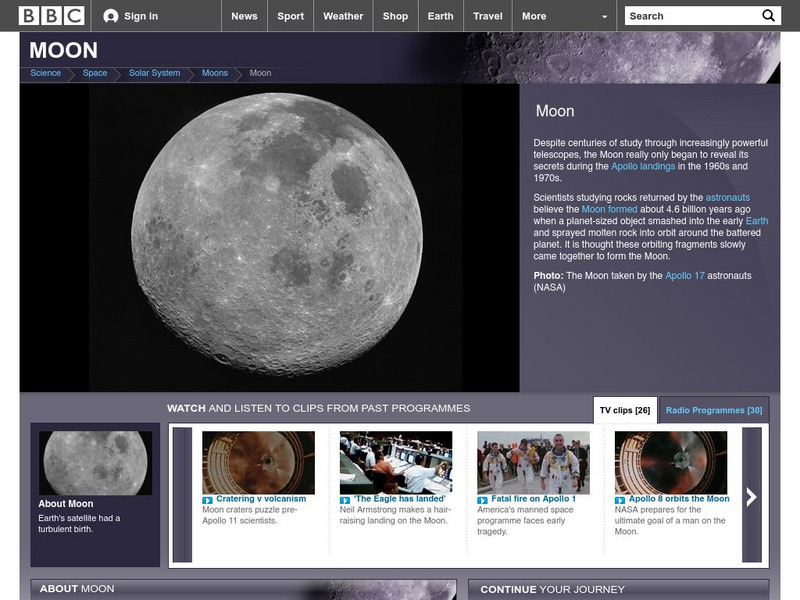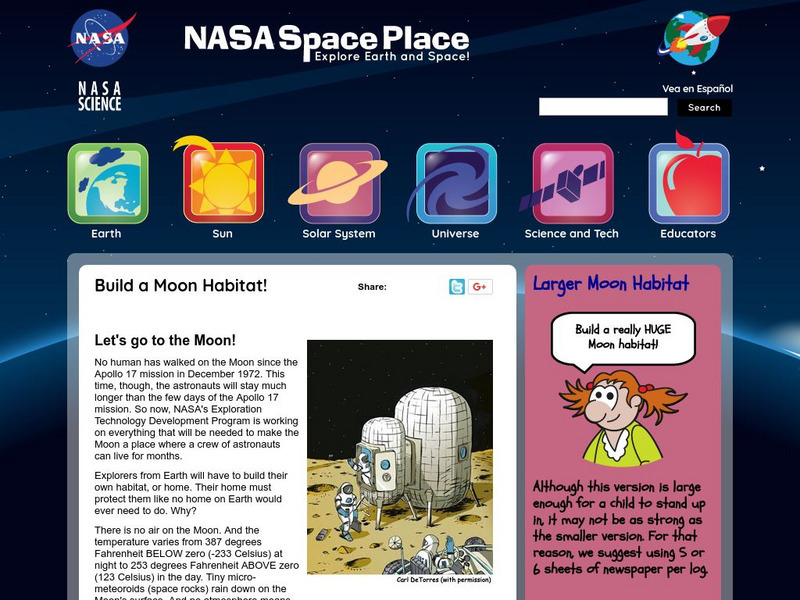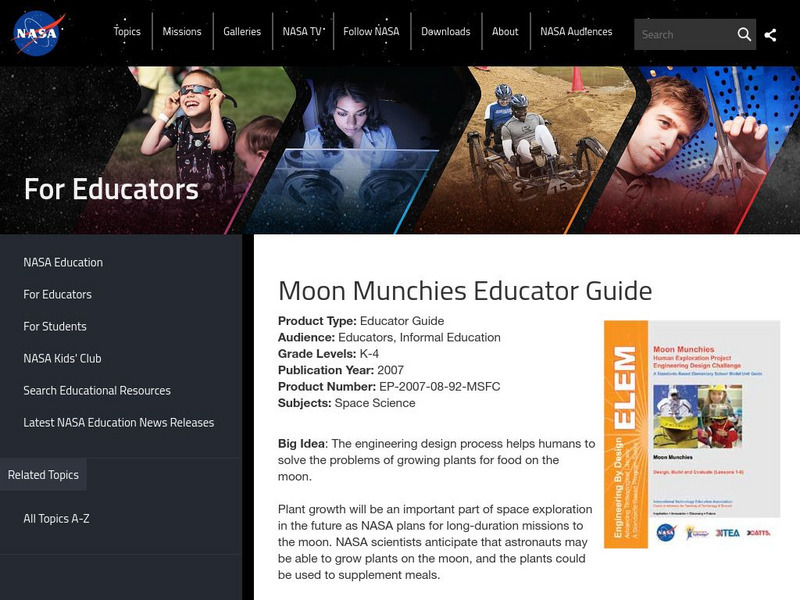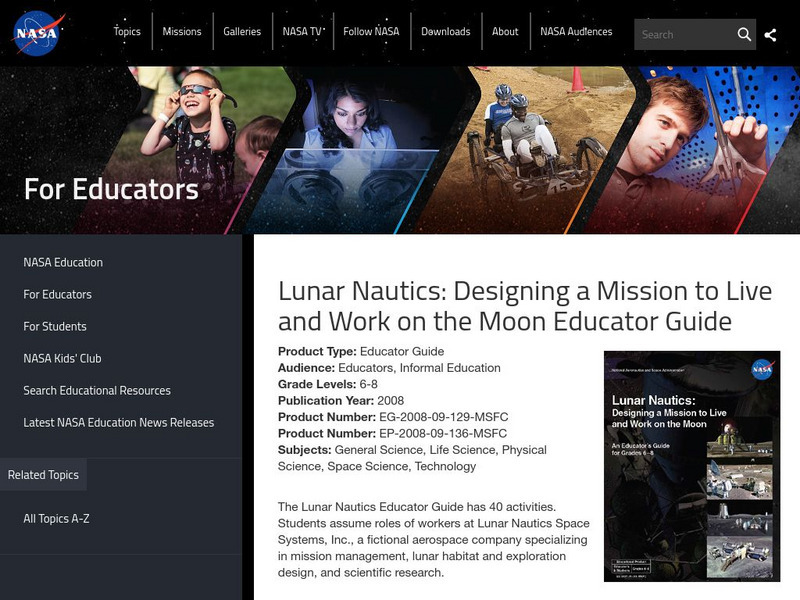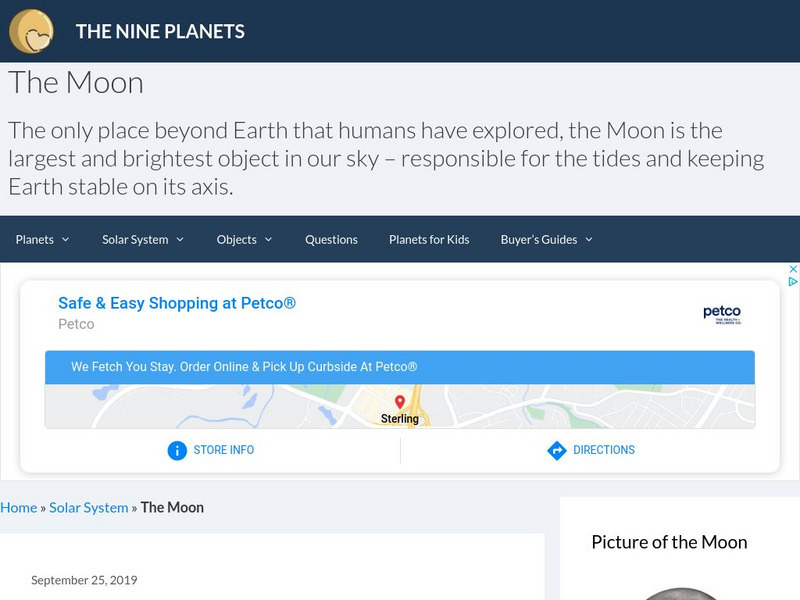Hi, what do you want to do?
California Institute of Technology
Cool Cosmos: Ask an Astronomer for Kids
Cool Cosmos, a NASA-affiliated site, has compiled a list of frequently asked questions about the moon and linked them to answers provided by actual astronomers! Click back to the Cool Cosmos home to access the Spanish-language version.
BBC
Bbc Science and Nature: The Moon
The BBC brings together a lot of useful information about the moon and related topics, such as the lunar landings, and publishes it in the form of a traveler's guide.
Seeker
Seeker: Week of 8 11 14: The Supermoon as Seen Around the World
View images of the recent supermoon phenonemon.
Google
Google: Moon
An exciting new way to explore the Apollo moon missions, visit the moon on this interactive map and take a tour of each Apollo landing.
NASA
Nasa: 21rd Century Explorer: Why Return to the Moon Before Going to Mars?
This short article elaborates on why it's important to have more space missions to the moon before sending a manned space mission to Mars. Follow links to learn more about NASA's other space missions.
Other
Lunar and Planetary Institute: Ranger Photographs of the Moon
Lunar atlas containing selected Ranger mission photographs and documentation.
Other
Lpi: Digital Lunar Orbiter Photographic Atlas of the Moon
The Lunar Orbiter Photographic Atlas of the Moon was originally assembled in 1971 and was the first of its kind to visually present a complete atlas of the surface of the moon. This is the digital version of that atlas.
Science Buddies
Science Buddies: The Moon and the Stars
When you are in the city, only a few of the brightest stars are visible. But when you are in the country, you can see many more stars than you can count. Sometimes you can even see the bright belt of our galaxy, the Milky Way. In this...
Georgia Department of Education
Ga Virtual Learning: The Moon
In this interactive tutorial students will explore what it is like on the Moon. Learn why the shape of the Moon seem to change and also about lunar eclipses. Discover why the tide changes twice a day and explore how the cycle of the Moon...
NASA
Nasa: The Space Place: Build a Moon Habitat
Let's go to the Moon! An activity engaging students in creating a moon habitat out of newspaper.
NASA
Nasa: Space Place: How Far Away Is the Moon
Often when we see drawings of the Earth and the moon, they look really close together. Check out this cartoon series that helps illustrate the reality of this concept.
DOGO Media
Dogo News: September Ends With Rare Black Moon
We've seen a full moon, a half moon, a blue moon, but how often do we get to see a black moon? Find out what a black moon is, why it is so rare, and what it looks like.
TeachEngineering
Teach Engineering: Life on the Moon
Students learn about the physical properties of the Moon. They compare these to the properties of the Earth to determine how life would be different for people living on the Moon. Using their understanding of these differences, they...
NASA
Nasa: Exploration: Then and Now: Settlement Lesson
This lesson plan has students examine different land to determine whether settlement is affected by an area's location, soil, and weather.
NASA
Nasa: Moon Munchies Educator Guide
This educator guide provides teachers with an outline for the entire Moon Munchies unit. Students will be able to design and build a lunar plant growth chamber using the Engineering Design Process.
NASA
Nasa: Lunar Nautics: Design Mission to Live & Work on Moon Educator Guide
This guide provides students the opportunity to simulate working at an aerospace company. Activities include designing a lunar lander and robot, building spacecraft, and much more.
Nine Planets
The Nine Planets: The Moon
Explore the mythology, structure, observational history, gravitational force, and orbit of Earth's Moon.
Sophia Learning
Sophia: Bill Nye: Once in a Mega Moon
Bill Nye explains why the moon appears smaller when it is higher in the sky, and he presents a Home Demo experiment that proves its an illusion. The experiment requires a bright moon on a clear night, a stiff piece of cardboard, and a...
Annenberg Foundation
Annenberg Learner: Moon Journal Activity
Young scholars use the process of journaling to make discoveries about the moon. This activity involves having students write observations about the moon in a journal. Using their observations they go to an online resource and choose...
Other
Planetary Society: Relative and Absolute Ages in Histories of Earth and the Moon
A lengthy scholarly article that discusses the geologic time scale, its history of development, age-dating events that occurred in different eras, and how absolute and relative dating are used to assess the ages of the Earth and Moon....
Other
First Men on the Moon: Experience the Apollo 11 Lunar Landing
Watch, listen, and relive the excitement of the Apollo 11 lunar landing as experienced minute-by-minute by the courageous crew of Apollo 11 and Mission Control.
Globio
Glossopedia: Moon
Orbiting around Earth at an average distance of 384,392km is our constant companion, the Moon. This and a great deal more can be learned about our closest neighbor in this article by GLOBIO
NASA
Nasa: Diameter of the Moon: Grades 4 12
This lab activity allows students to calculate the diameter of the moon using proportions. Also follow links to other NASA lesson plans.
NASA
Nasa: Exploring the Moon Educator Guide
This NASA educator guide provides teachers with an outline for teaching a unit about the Moon. Find lessons and hands-on activities about the different parts of the Moon and lunar landing sites.






